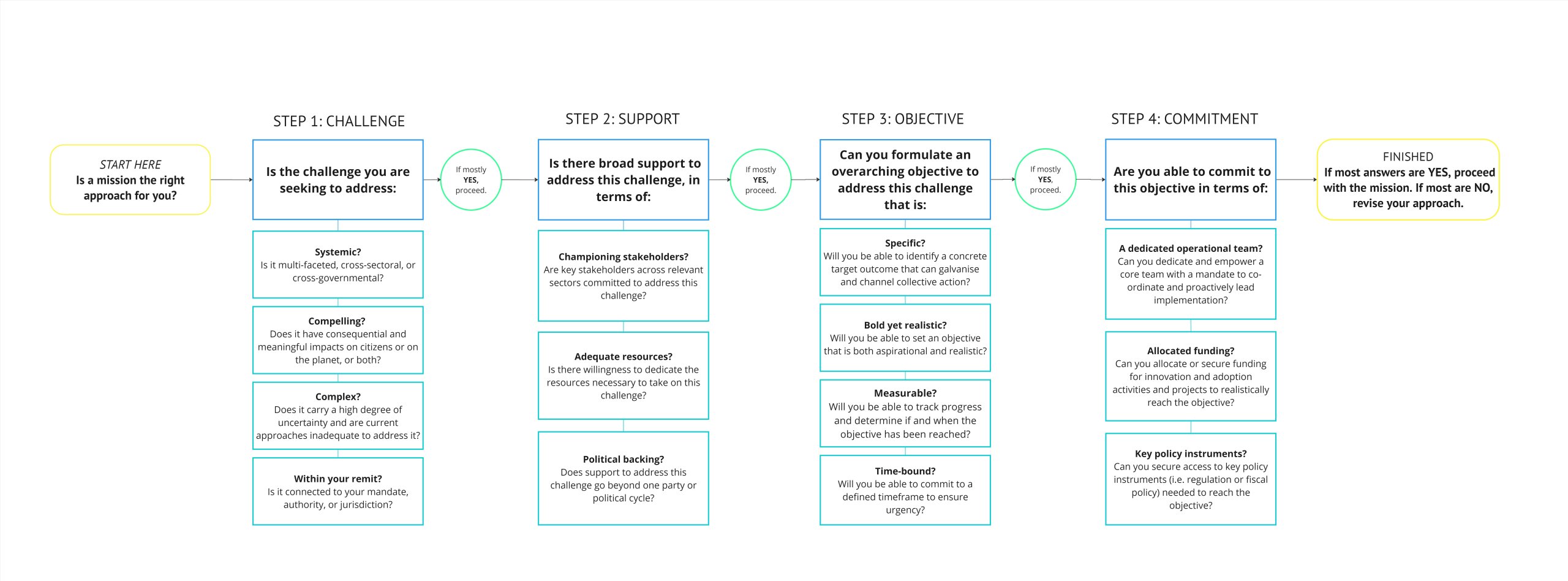Closing the Gender Digital Divide: A Mission-Readiness Exploration in Latin America and the Caribbean

What conditions need to be in place to consider a mission-oriented innovation approach in a low or middle-income country? How can policy makers assess government capabilities, innovation ecosystem maturity and the international development cooperation sector dynamics to take informed decisions related to mission-oriented innovation?
As the interest in mission-oriented innovation is growing among policymakers worldwide and in the development cooperation sector, there is a growing appetite in exploring how such concepts practically apply across high, middle and low-income countries. This article draws on initial research into how mission-oriented innovation can be adapted in low and middle-income countries (LMICs).
Mission-oriented innovation policies entail a diverse mix of interventions and requires Government to take a lead role to collectively design and steer a portfolio of solutions. A mission approach seeks to deliberately shape markets, and to design and steer a portfolio of solutions that spans across traditional sectoral and technology boundaries (see: A brief guide to mission terminology, and OECD Mission-Oriented Innovation Policies Online Toolkit).
In 2024, we at the OECD Innovation for Development Facility and the Mission Action Lab, started a collaboration with partners in Colombia and the Dominican Republic, alongside the BMZ[1], GIZ[2], and ECLAC[3], on an action-research initiative related to the gender digital divides. We set out to deliver across three phases detailed below.
Gender Digital Divides : why it matters
Across Latin America and the Caribbean (LAC), persistent gender-driven digital divides continue to limit women’s and vulnerable population’s participation in society. Affordability is one of the main barriers to broadband uptake in many countries, and in LAC, approximately 4 out of every 10 women either lack connectivity or cannot afford it. These divides overlap with other persistent economic and social inequalities.
Gender gaps in the digital space are multi-dimensional. Women and girls, especially those in rural and marginalised settings, face barriers to affordable internet and lack relevant skills for its appropriate use. Additionally, exposure to online harassment and gender-based violence, discourages women’s active and sustained engagement in digital spaces. There is also a widespread absence of online content that supports women’s needs and rights. These gaps mirror structural power inequalities offline and hinder economic growth.
A recent study found that closing gender gaps in labour markets could increase GDP in LAC countries by up to 14 per cent by 2030. Tackling these divides requires structural reforms across education, technology, governance, and efforts to change social norms. The cross-sectoral nature of this challenge makes a mission approach potentially relevant.
Phase One – Assessment
Through our action-research initiative, we mapped key mission-oriented policies and initiatives addressing gender digital divides in both countries. Later, we launched a survey tool, adapted from OECD’s MAL work with Austria. The survey was refined through local co-design to reflect local context. It assessed the strategic orientation, coordination, and implementation of relevant policy instruments, programmes. Results we complemented with focus group discussions and semi-structured interviews.
In Colombia, while no mission specifically addresses the gender digital divide, programmes such as Mujeres TIC para el Cambio and CiberPaz embed gender in digital strategies, alongside broader frameworks like the National Digital Strategy 2023–2026, and the Public Policy on Gender Equity for Women (CONPES[4] 4080).
The Dominican Republic has not yet formally adopted a mission-oriented innovation approach to address the gender digital divide, however in December 2023 the country joined the global 50-in-5 campaign, reinforcing its ambition to accelerate digital public infrastructure through open technologies and digital public goods, in parallel with strategies like the National Development Strategy 2030, Digital Agenda 2030, National Innovation Policy 2030.
Emerging insights
- In both countries, experts assessed the greatest needs for improvements in the area of implementation. In the Dominican Republic, specific implementation challenges of key education policies pose barriers for women’s digital inclusion.
- Both countries emphasise the need for better coordination across government entities and with development partners and sustained budget commitments. In Colombia, initial findings highlight that coordination between national and territorial levels is weak, leading to fragmented initiatives.
Phase Two – Assessing mission options
In late 2025, we will explore options w in both countries to design and launch a mission. Here are important considerations for the way forward:
The political window: is the timing right? Missions are very dependent on political context. Windows of opportunities related to realpolitik as well as levels of popular support matter.
The appropriateness: is a mission an appropriate policy response to the gender digital divide? We will use the ‘Mission Litmus Test’ to assess if this approach adds value.

Mission-readiness: We are developing a tool to assess whether a specific context is conducive for a mission approach. The objective is to provide government decision-makers an understanding of the current capabilities. Assessments will draw on governance mechanisms (and ‘mission maturity assessment’ by Nesta); the local innovation ecosystem, and the international development cooperation system dynamics.
Phase Three – How to (potentially) launch a mission
If conditions allow, the next step will be co-designing a mission in both countries. This would include building a theory of change and a theory of action to guide mission processes and systemic effects. These will form the foundation for defining a mission portfolio and coordinating efforts across government and development partners.
Stay tuned for updates. If you are interested in collaborating on the Mission Readiness Assessment tool targeting LMICs, contact us: [email protected]
_____
This initiative would not have been possible without the insights and collaboration of our partners in Colombia and the Dominican Republic: Anamaría Sanabria Merlo, Sara Márquez Gutiérrez, Andrés Lozano Reyes, and Amparo Arango Echeverri. We also want to extend our sincere thanks to innovation experts from the OECD Mission Action Lab: Charles McIvor, Philippe Larrue, and Piret Tõnurist.
[1] German Federal Ministry for Economic Cooperation and Development
[2] German Corporation for Development Cooperation
[3] Economic Commission for Latin America and the Caribbean
[4] CONPES stands for Consejo Nacional de Política Económica y Social (National Council for Economic and Social Policy)












